 K.
K.CHAPTER 20
The Power of High Cards
It is never too early or too late to learn to play bridge.
When playing a hand, you often look to the four honours in each suit – the ace, king, queen and jack – to take tricks. If, however, you see these cards only in the light of their ability to take a single trick, you are underestimating their importance. Let’s first consider the ace. Certainly it is usually good for taking a trick. But did you know that it has the power to prevent the opponents from taking their winners? Or to enable you, the declarer, to be in the right place at the right time in order to take winners. The ace, and your other high cards, are valuable members of your team.
Using high cards to prevent the opponents from taking winners
A high card in a suit only wins a trick if you manage to play it. Taking winners consists not only of developing the winners in the first place but also of being in the right place at the right time. Consider this layout of the diamond suit. You are in a no-trump contract and West leads the  K.
K.

It looks as if you have only one trick in the suit, which you can win with the  A. The opponents, on the other hand, have established five winners after your
A. The opponents, on the other hand, have established five winners after your  A is played. At first glance, there may seem to be nothing you can do about the situation. But remember, winners are only good if you have a way to get to them. It is true that your ace has the power to take only one trick. Another way of looking at the situation, however, is to consider not only the trick-taking power of the card but the way it can control a suit. Played at the right time, it may prevent the opponents from taking all five of their diamond tricks. Timing is everything.
A is played. At first glance, there may seem to be nothing you can do about the situation. But remember, winners are only good if you have a way to get to them. It is true that your ace has the power to take only one trick. Another way of looking at the situation, however, is to consider not only the trick-taking power of the card but the way it can control a suit. Played at the right time, it may prevent the opponents from taking all five of their diamond tricks. Timing is everything.
Suppose you play your  A on the
A on the  K. Unless you can immediately take enough tricks to make your contract, you will have to give the lead to the opponents while you are developing the winners you need. If West gets the lead, he will take his diamond winners. If East gets the lead, he will be able to lead his remaining small diamond to West’s promoted winners. Either way, the opponents take five diamond tricks. What can you do to prevent this?
K. Unless you can immediately take enough tricks to make your contract, you will have to give the lead to the opponents while you are developing the winners you need. If West gets the lead, he will take his diamond winners. If East gets the lead, he will be able to lead his remaining small diamond to West’s promoted winners. Either way, the opponents take five diamond tricks. What can you do to prevent this?
Suppose you don’t play your  A until the second trick. The defenders will have collected one diamond trick. What has changed? You still may have to give up the lead to the opponents. This time, however, if it is East who gets the lead, he will have no diamonds left to lead back to West’s winners. Of course, West may have an entry in another suit, or it may be West that gets the lead when you are developing the winners you need. Too bad. At least you gave yourself the best chance. By holding up your ace until the second round, you may hold the opponents to only one trick in the diamond suit.
A until the second trick. The defenders will have collected one diamond trick. What has changed? You still may have to give up the lead to the opponents. This time, however, if it is East who gets the lead, he will have no diamonds left to lead back to West’s winners. Of course, West may have an entry in another suit, or it may be West that gets the lead when you are developing the winners you need. Too bad. At least you gave yourself the best chance. By holding up your ace until the second round, you may hold the opponents to only one trick in the diamond suit.
Let’s look at this idea in a complete hand. You are in 3NT and the opening lead is the  K.
K.
Contract: 3NT

You need to take nine tricks to make your contract of 3NT. Count your winners: four spades, one diamond and two clubs, a total of seven. Two more winners need to be developed and the heart suit offers a good opportunity to promote the winners you need. Organize your plan. If you plan to take the  A on the first trick and try to develop your heart winners, whichever defender wins the
A on the first trick and try to develop your heart winners, whichever defender wins the  A will be able to lead a diamond and the defenders can take all their diamond winners. On the actual hand, West has four promoted winners and the defenders defeat your contract.
A will be able to lead a diamond and the defenders can take all their diamond winners. On the actual hand, West has four promoted winners and the defenders defeat your contract.
We need to organize a plan with more chance of success. This time, let West win the first two diamond tricks, and take the third round of diamonds with the  A. After three rounds of diamonds have been played you have lost only two tricks. Now, try to promote your heart winners. East takes the trick with the
A. After three rounds of diamonds have been played you have lost only two tricks. Now, try to promote your heart winners. East takes the trick with the  A, you can’t prevent that. However, on the actual hand, East has no diamonds left to get back into West’s hand and has to lead another suit. Whether East chooses spades, hearts or clubs, you are ready to take your nine tricks.
A, you can’t prevent that. However, on the actual hand, East has no diamonds left to get back into West’s hand and has to lead another suit. Whether East chooses spades, hearts or clubs, you are ready to take your nine tricks.
Are we just lucky that East has the  A and no diamonds left? Not really. The opponents have eight cards in the diamond suit and you would expect them to be divided 5–3. If East had a diamond left to lead back when he won the
A and no diamonds left? Not really. The opponents have eight cards in the diamond suit and you would expect them to be divided 5–3. If East had a diamond left to lead back when he won the  A, they would have originally been divided 4–4 and the opponents would only end up with three diamond tricks and one heart trick. You would still make the contract. At any rate, if West holds the
A, they would have originally been divided 4–4 and the opponents would only end up with three diamond tricks and one heart trick. You would still make the contract. At any rate, if West holds the  A along with a five-card diamond suit, there is nothing you can do to make your contract. You gave it the best chance.
A along with a five-card diamond suit, there is nothing you can do to make your contract. You gave it the best chance.
When you choose to play low on a trick when you could win it, it is called a holdup play. The ace is not the only card you can use when making a holdup play. After the ace has been played, the king, the next highest card, takes over the ace’s position and its importance. In the previous example, we saw that, by holding up the ace, you can prevent the defenders from getting to their promoted winners. When the ace has been played, holding up the king can have the same effect. Consider this layout. You are in 3NT and West leads a small diamond, the  7:
7:

You play a small card from the dummy, East takes the first trick with the  A, and leads another diamond. After the
A, and leads another diamond. After the  A has been played, your
A has been played, your  K is the highest outstanding card in the suit. If you take it on the second round, diamonds will have been played twice, with one trick won by the defenders and one trick by you. The layout of the suit would now be the following:
K is the highest outstanding card in the suit. If you take it on the second round, diamonds will have been played twice, with one trick won by the defenders and one trick by you. The layout of the suit would now be the following:

You have the lead and, unless you are taking the next eight tricks, enough to make your contract, you will have to give the lead to the opponents while developing the extra winners you need. Whether East or West gets the lead, the defenders are ready to take three diamond tricks.
Suppose, on the second round of the suit, you hold up your  K. East can play the suit again and, on the third round, you take
K. East can play the suit again and, on the third round, you take  K. Now diamonds have been played three times. You have taken one trick with the
K. Now diamonds have been played three times. You have taken one trick with the  K and the opponents have taken two tricks. The layout of the suit is now:
K and the opponents have taken two tricks. The layout of the suit is now:

Although West has two established winners, they are of no value if East gets the lead. He has to lead another suit and with luck, you are then in a position to take enough tricks to make your contract. This isn’t a guaranteed method of making your contract, but it does give you some chance.
Notice the difference between the above situation and this layout:

If West leads a small diamond and East puts on the  Q, your
Q, your  K does not have the power of the ace because the
K does not have the power of the ace because the  A has not been played. This is not the time to hold up your king. You will have to take it – to avoid the possibility of losing the first five diamond tricks – and hope you can develop the tricks you need without giving up the lead to the opponents.
A has not been played. This is not the time to hold up your king. You will have to take it – to avoid the possibility of losing the first five diamond tricks – and hope you can develop the tricks you need without giving up the lead to the opponents.
Using high cards as entries
High cards can provide a means of transport from one side of the table to another. Why is this important? Not only do you need entries to get to your promoted or established winners, you also need them to be able to try finesses. In order to lead towards the card you hope will take a trick, you have to be in the hand opposite the high card – and that requires an entry. You also need to be on the right side of the table to trump losers in the dummy or to throw away a loser in the declarer’s hand on the dummy’s extra strength.
High cards as entries to small cards in long suits
Long suits provide an excellent opportunity to develop the extra tricks to make your contract. When a small card is part of a long suit, it can be developed into a winner. Usually, your long suits have one or two honour cards and these have to be carefully handled, being played at the right time in order to take best advantage of them. Let’s first consider a suit which has length in the dummy but no outside card to get to any established winners. That means that the dummy’s high card in the suit has to be carefully handled.
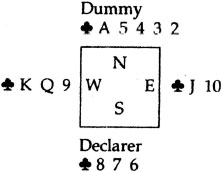
The  A will take one trick in the club suit. You want to be more ambitious than expecting only one trick from this suit, however. You are hoping the five cards that the opponents have are distributed as in the layout, 3–2. You can get one trick with the
A will take one trick in the club suit. You want to be more ambitious than expecting only one trick from this suit, however. You are hoping the five cards that the opponents have are distributed as in the layout, 3–2. You can get one trick with the  A, lose two tricks to the opponents and thereby establish the two remaining clubs in the dummy as winners – provided you can get to them. The
A, lose two tricks to the opponents and thereby establish the two remaining clubs in the dummy as winners – provided you can get to them. The  A provides not only a trick, but also your means of transport to the established winners. If you play the
A provides not only a trick, but also your means of transport to the established winners. If you play the  A on the first or second trick, you have no way of getting the winners. On the other hand, if you lose two tricks and then take your
A on the first or second trick, you have no way of getting the winners. On the other hand, if you lose two tricks and then take your  A on the third round, you are not only winning the trick you expected with the
A on the third round, you are not only winning the trick you expected with the  A, but you have taken it at the right time, after your small cards are established. In total, you take three tricks in the suit.
A, but you have taken it at the right time, after your small cards are established. In total, you take three tricks in the suit.
High cards as entries to promoted winners
When you are promoting winners in one suit, you often need an entry in another suit to get to the promoted winners. Sometimes, when you have both an ace and a king in a side suit, you might think that the order in which you play these high cards doesn’t matter. Nothing could be further from the truth. The order is usually very important. In order to emphasize this point, let’s consider an entire hand. Your are in a contract of 3NT and West leads the  Q. Since you have both the
Q. Since you have both the  A and the
A and the  K, you have a choice of which card you play on the first trick. Which honour would you use to take the first trick?
K, you have a choice of which card you play on the first trick. Which honour would you use to take the first trick?
Contract: 3NT
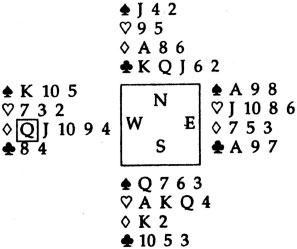
You need nine tricks to make the contract. You have three sure heart tricks, and two diamonds, a total of five tricks. Four more need to be developed and the club suit offers excellent potential. After the  A is driven out, you will have promoted the four tricks you need to make your contract. East will probably make things as difficult as possible by holding up the
A is driven out, you will have promoted the four tricks you need to make your contract. East will probably make things as difficult as possible by holding up the  A until the third round. You will have taken two tricks in the suit, and will have lost one. Your two clubs in the dummy are promoted as winners. All you have to do is get to them. Which diamond did you play on the first trick? Let’s hope you played the
A until the third round. You will have taken two tricks in the suit, and will have lost one. Your two clubs in the dummy are promoted as winners. All you have to do is get to them. Which diamond did you play on the first trick? Let’s hope you played the  K from your hand, leaving the
K from your hand, leaving the  A in the dummy as an entry to your promoted clubs. You can see on this hand that the diamonds not only took two tricks but provided the potential for two extra tricks in another suit.
A in the dummy as an entry to your promoted clubs. You can see on this hand that the diamonds not only took two tricks but provided the potential for two extra tricks in another suit.
Using your high cards to take a finesse
Take a look at this layout:

The  A and
A and  Q will take only one trick overall if you lead them from your hand. On the other hand, if you lead a low spade from the dummy towards the ace-queen combination, there is the potential for two tricks in the suit: one with the
Q will take only one trick overall if you lead them from your hand. On the other hand, if you lead a low spade from the dummy towards the ace-queen combination, there is the potential for two tricks in the suit: one with the  A and one with the
A and one with the  Q. It isn’t a 100 per cent chance, but it is a 50 per cent chance and that is worth trying if that is the only way of getting the extra trick you need. In order to take a trick with the
Q. It isn’t a 100 per cent chance, but it is a 50 per cent chance and that is worth trying if that is the only way of getting the extra trick you need. In order to take a trick with the  Q you have to start from the dummy. You therefore need an entry to the dummy.
Q you have to start from the dummy. You therefore need an entry to the dummy.
We will discuss the play of trump contracts in detail in the next section of the book, but here are some examples of the power of high cards in trump contracts.
The following hand shows how carefully your entries have to be used. The contract is 4 and the opening lead is the
and the opening lead is the  2:
2:
Contract: 4

You can afford only three losers and it looks as though you will have to lose a diamond trick and two club tricks. So you cannot afford to lose a spade trick, even though you are missing the  K. You will have to hope that East has the
K. You will have to hope that East has the  K and you can take repeated finesses through him to avoid losing a spade trick. What are you going to use for entries to the dummy? Only the trump suit will provide the entries you need. Since you may have to repeat the finesse three times, you will have to combine carefully drawing trumps with leading spades from the dummy at every opportunity.
K and you can take repeated finesses through him to avoid losing a spade trick. What are you going to use for entries to the dummy? Only the trump suit will provide the entries you need. Since you may have to repeat the finesse three times, you will have to combine carefully drawing trumps with leading spades from the dummy at every opportunity.
After winning the first diamond trick, play a heart to one of the dummy’s high cards and lead a small spade towards your hand. Assuming East follows with a small spade, finesse the  10 (or
10 (or  J or
J or  Q). When this wins, cross back to the dummy with another heart and lead another low spade, repeating the finesse. As you cross to the dummy for a third time, you draw the last trump and end up in the right place to lead your final small spade from the dummy and take one more finesse. Only by careful use of each of the dummy’s high hearts can you make the contract.
Q). When this wins, cross back to the dummy with another heart and lead another low spade, repeating the finesse. As you cross to the dummy for a third time, you draw the last trump and end up in the right place to lead your final small spade from the dummy and take one more finesse. Only by careful use of each of the dummy’s high hearts can you make the contract.
Using high cards as entries for getting rid of losers
Let’s see how important our high cards are in helping to be in the right hand when trumping losers in the dummy. The contract is 6 and the lead is the
and the lead is the  3:
3:
Contract: 6
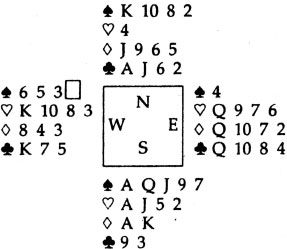
To make your slam, you can only afford one loser. There are three heart losers and a club loser to worry about and, since there is not much you can do about the club loser, you plan to trump the heart losers in the dummy. West’s trump lead, removing one of the dummy’s trumps, has not helped your cause. You cannot afford to use your trumps as entries or let the opponents in to lead another trump, as that would leave you with too few trumps in the dummy. Instead, win the trump lead and immediately play the  A and trump a heart in the dummy. Cross to the
A and trump a heart in the dummy. Cross to the  A and trump another heart in the dummy. Come back to the
A and trump another heart in the dummy. Come back to the  K and trump your last heart in the dummy. The only loser you are left with is a club and you end up making the contract.
K and trump your last heart in the dummy. The only loser you are left with is a club and you end up making the contract.
Finally, let’s look at a hand where you need to discard a loser:
Contract: 4

In 4  , you can afford three losers. Provided the missing trumps are divided 3–2, you will not have to lose a spade trick, but you will have two losers in diamonds and in clubs. If West has the
, you can afford three losers. Provided the missing trumps are divided 3–2, you will not have to lose a spade trick, but you will have two losers in diamonds and in clubs. If West has the  A, you can lead twice towards the dummy’s
A, you can lead twice towards the dummy’s  K and
K and  Q to lose only one diamond trick. But, if the
Q to lose only one diamond trick. But, if the  A is with East, you will have to find another way to take care of your second diamond loser. The heart suit provides an opportunity to discard one of your losers, but you will have to plan the play carefully since the club lead has driven out the dummy’s only quick entry. Win the
A is with East, you will have to find another way to take care of your second diamond loser. The heart suit provides an opportunity to discard one of your losers, but you will have to plan the play carefully since the club lead has driven out the dummy’s only quick entry. Win the  A, draw trumps, and then play the
A, draw trumps, and then play the  A and
A and  Q. Now you can lead a diamond to create an entry to the dummy’s
Q. Now you can lead a diamond to create an entry to the dummy’s  K. Once you get to the dummy with the
K. Once you get to the dummy with the  K or
K or  Q, discard your remaining diamond loser on the
Q, discard your remaining diamond loser on the  K.
K.
Your high cards are important not only for the tricks they can take but for the influence they have in enabling you to take the tricks you have worked to develop and to prevent the opponents from taking the tricks they have developed.
Summary
The high cards in the deck are a good source for taking tricks. They have other powers. By using the holdup play, you can prevent the opponents from taking good tricks because your holdup has prevented them from getting to their winners. When you have the tricks you need, you have to get to them and the high cards provide a means of transport to get from one side of the table to another. This is important not only in taking your high cards but in developing the extra tricks you need through promotion, length in a suit and the finesse which can be used in either no-trump or suit contracts. The high cards are also important entries when you are getting rid of your losers by either trumping in the dummy or throwing away losers on the dummy’s extra strength.
Over Zia’s shoulder
Hand 1 Dealer: North
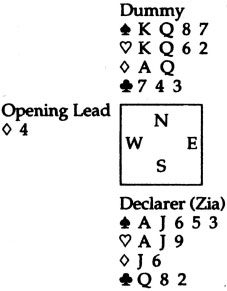
|
N |
E |
S |
W |
|
1 |
Pass |
1 |
Pass |
|
3 |
Pass |
4 |
Pass |
|
4 |
Pass |
What should we play on the first diamond trick? It is always tempting to take a finesse when we have been given the opportunity to make use of our high cards in this fashion. However, our high cards can be useful in other ways as well. Let’s go through the plan before making our decision.
Solution to Hand 1:
Contract: 4

|
S |
We can afford only three losers in our contract of 4 |
|
T |
We have a diamond loser and three club losers. |
|
O |
We could try the diamond finesse, getting rid of our diamond loser if West holds the |
|
P |
One of the extra powers of an ace is its ability to give us control of a suit by taking a trick at the right time. On this hand, we must take the |
Hand 2 Dealer: East
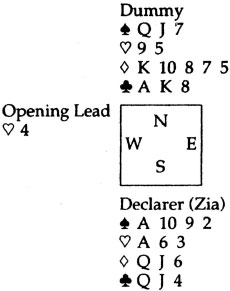
|
N |
E |
S |
W |
|
Pass |
1NT |
Pass |
|
|
3NT |
Pass |
Pass |
Pass |
It looks as though we have a choice of taking a spade finesse or driving out the  A to develop the extra tricks we need. Are there any other considerations?
A to develop the extra tricks we need. Are there any other considerations?
Solution to Hand 2:
Contract: 3NT
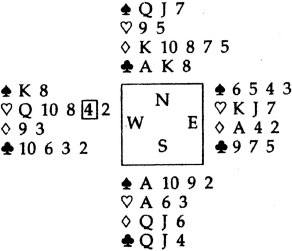
|
S |
We need to come up with nine tricks to make this contract. |
|
T |
We have one sure spade trick, one heart trick and three club tricks, for a total of five. |
|
O |
We need four more tricks. We could try leading the |
|
P |
We let the opponents win the first heart trick, and the second heart trick. Only when they lead the third round of hearts do we win the trick with our |
Hand 3 Dealer: West

|
N |
E |
S |
W |
|
Pass |
|||
|
Pass |
Pass |
2NT |
Pass |
|
3NT |
Pass |
Pass |
Pass |
It looks as though we may have some difficulty coming to nine tricks with these cards. West’s opening lead has simplified things a little, since we are now assured of getting two spade tricks, whichever player has the  K. What’s our plan?
K. What’s our plan?
Solution to Hand 3:
Contract: 3NT
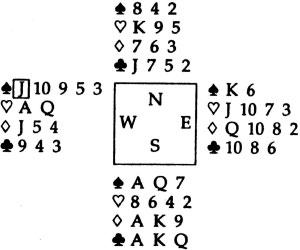
|
S |
We need to find nine winners. |
|
T |
We have two sure spade tricks, the |
|
O |
The best place for a ninth trick is the heart suit. If West has the |
|
P |
After winning the first spade trick, we’ll have to play the |